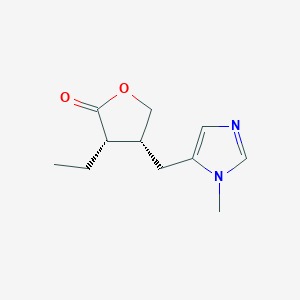Attribution Statement: LactMed is a registered trademark of the U.S. Department of Health and Human Services.
NCBI Bookshelf. A service of the National Library of Medicine, National Institutes of Health.
Drugs and Lactation Database (LactMed®) [Internet]. Bethesda (MD): National Institute of Child Health and Human Development; 2006-.
CASRN: 92-13-7

Drug Levels and Effects
Summary of Use during Lactation
Limited information indicates that maternal use of ophthalmic pilocarpine did not adversely affect the breastfed infant. If ophthalmic pilocarpine is used during breastfeeding, monitor the infant for signs of cholinergic excess (diarrhea, lacrimation, and excessive salivation or urination), especially in younger, exclusively breastfed infants. To substantially diminish the amount of drug that reaches the breastmilk after using eye drops, place pressure over the tear duct by the corner of the eye for 1 minute or more, then remove the excess solution with an absorbent tissue.
Because no information is available on the use of oral pilocarpine during breastfeeding, an alternate drug may be preferred, especially while nursing a newborn or preterm infant.
Drug Levels
Maternal Levels. Relevant published information was not found as of the revision date.
Infant Levels. Relevant published information was not found as of the revision date.
Effects in Breastfed Infants
A woman with glaucoma used a pilocarpine insert (Ocusert; strength not specified) in one eye while nursing (extent not stated) her newborn infant for 9 weeks. No adverse reactions were noted in the infant.[1]
A mother who was taking pilocarpine eye drops (concentration not stated) twice daily as well as 2 drops of timolol 0.5% eye drops daily and acetazolamide 250 mg orally twice daily and delivered a preterm infant at 36 weeks of gestation. The infant began 5 months of exclusive breastfeeding at 6 hours after birth. On day 2, the infant developed electrolyte abnormalities consisting of hypocalcemia, hypomagnesemia, and metabolic acidosis. The infant was treated with oral calcium gluconate and a single dose of intramuscular magnesium sulfate. Despite continued breastfeeding and maternal drug therapy, the infant's mild metabolic acidosis disappeared on day 4 of life and the infant was gaining weight normally at 1, 3 and 8 months, but had mild hypotonicity. The authors considered the metabolic effects to be caused by transplacental passage of acetazolamide that resolved despite the infant being breastfed. The infant gained weight adequately during breastfeeding, but had some mild, residual hypertonicity of the lower limbs requiring physical therapy.[2]
Effects on Lactation and Breastmilk
Relevant published information in nursing mothers was not found as of the revision date. In animals, cholinergic drugs increase oxytocin release,[3] and have variable effects on serum prolactin.[4] Other centrally acting cholinergic drugs increase serum prolactin in humans.[5][6] The prolactin level in a mother with established lactation may not affect her ability to breastfeed.
References
- 1.
- Lustgarten JS, Podos SM. Topical timolol and the nursing mother. Arch Ophthalmol. 1983;101:1381-2. [PubMed: 6615302]
- 2.
- Merlob P, Litwin A, Mor N. Possible association between acetazolamide administration during pregnancy and metabolic disorders in the newborn. Eur J Obstet Gynecol Reprod Biol. 1990;35:85-8. [PubMed: 2311821]
- 3.
- Clarke G, Fall CH, Lincoln DW, Merrick LP. Effects of cholinoceptor antagonists on the suckling-induced and experimentally evoked release of oxytocin. Br J Pharmacol. 1978;63:519-27. [PMC free article: PMC1668097] [PubMed: 566601]
- 4.
- Muller EE, Locatelli V, Cella S et al. Prolactin-lowering and -releasing drugs: mechanisms of action and therapeutic applications. Drugs. 1983;25:399-432. [PubMed: 6133737]
- 5.
- Risch SC, Janowsky DS, Siever LJ et al. Correlated cholinomimetic-stimulated beta-endorphin and prolactin release in humans. Peptides. 1982;3:319-22. [PubMed: 6289276]
- 6.
- Risch SC, Janowsky DS, Siever LJ et al. Cholinomimetic-induced co-release of prolactin and beta-endorphin in man. Psychopharmacol Bull. 1982;18:21-5. [PubMed: 6296908]
Substance Identification
Substance Name
Pilocarpine
CAS Registry Number
92-13-7
Drug Class
- Breast Feeding
- Antiglaucoma Agents
- Miotics
- Muscarinic Agonists
- Parasympathomimetics
Disclaimer: Information presented in this database is not meant as a substitute for professional judgment. You should consult your healthcare provider for breastfeeding advice related to your particular situation. The U.S. government does not warrant or assume any liability or responsibility for the accuracy or completeness of the information on this Site.
- User and Medical Advice Disclaimer
- Drugs and Lactation Database (LactMed) - Record Format
- LactMed - Database Creation and Peer Review Process
- Fact Sheet. Drugs and Lactation Database (LactMed)
- Drugs and Lactation Database (LactMed) - Glossary
- LactMed Selected References
- Drugs and Lactation Database (LactMed) - About Dietary Supplements
- Breastfeeding Links
- PMCPubMed Central citations
- PubChem SubstanceRelated PubChem Substances
- PubMedLinks to PubMed
- Review Brimonidine.[Drugs and Lactation Database (...]Review Brimonidine.. Drugs and Lactation Database (LactMed®). 2006
- Review Fluorometholone.[Drugs and Lactation Database (...]Review Fluorometholone.. Drugs and Lactation Database (LactMed®). 2006
- Review Flurbiprofen.[Drugs and Lactation Database (...]Review Flurbiprofen.. Drugs and Lactation Database (LactMed®). 2006
- Review Dexamethasone, Topical.[Drugs and Lactation Database (...]Review Dexamethasone, Topical.. Drugs and Lactation Database (LactMed®). 2006
- Review Azelastine.[Drugs and Lactation Database (...]Review Azelastine.. Drugs and Lactation Database (LactMed®). 2006
- Pilocarpine - Drugs and Lactation Database (LactMed®)Pilocarpine - Drugs and Lactation Database (LactMed®)
Your browsing activity is empty.
Activity recording is turned off.
See more...
